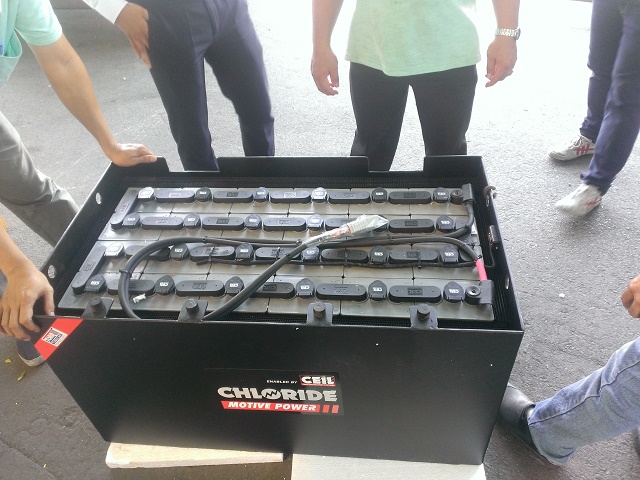How to Reconditioning Forklift Batteries
Recovering forklift batteries is actually restoring capacity for lead-acid batteries, extending the effective life of batteries. They are also called desulfurization processes, regulating or balancing electrolytes.
Forklift :
The lead sulfate layer can be dissolved in solution again by applying higher voltages. Normally, running high voltage into the battery will cause it to heat up quickly and potentially cause heat to cause it to explode. Some recovery processes Forklift batteries use short pulses of high voltage, too short to cause significant current, but long enough to reverse the crystallization process.
However, long-term use of high-voltage pulses has been shown to damage the polar plates of lead-acid batteries. The latest development of the forklift battery recovery process is to use frequency pulses compared to high voltage pulses to dissolve the accumulated sulfate into an electrolyte.
Frequency pulses are generated through: resonance between inductance and capacitance. The size of the battery is also a factor affecting the creation of large frequency pulses. However, electrochemical processes found in batteries have a constant over time and will not be affected by the frequency pulse.
Depending on the size of the forklift battery, the desalination process can take from 48 hours to several weeks to complete. During this period, the battery is also recharged to continue reducing the amount of lead sulfate in the solution.
See Forklift batteries:
Read more: The way to Reconditioning a Dry Battery on a Motorcycle
- Mark forklift batteries need maintenance.
- Classification of batteries based on average condition, including: Bottles with capacity from 20% - 70% of the rated capacity. The bottle has a capacity of over 70% to 85% of the rated capacity.
- Based on the evaluation results of the status of battery batteries, go to step 3 to select the chemical to restore forklift batteries suitable to the status of each type of battery.
- Absorb the acid solution in the battery to the extent possible.
- Pour recovery solution, soak for at least 4 hours.
- Load according to the recovery process from 20 hours to 24 hours.
- Re-titrate and supplement solution, measure capacity.
- Reload recovery in 10 hours.
Above are the tips for you to recover forklift batteries. Hope that these knowledge will help your battery improve durability and longevity.
Learn about how to recover many different types of batteries here:
Forklift :
The lead sulfate layer can be dissolved in solution again by applying higher voltages. Normally, running high voltage into the battery will cause it to heat up quickly and potentially cause heat to cause it to explode. Some recovery processes Forklift batteries use short pulses of high voltage, too short to cause significant current, but long enough to reverse the crystallization process.
However, long-term use of high-voltage pulses has been shown to damage the polar plates of lead-acid batteries. The latest development of the forklift battery recovery process is to use frequency pulses compared to high voltage pulses to dissolve the accumulated sulfate into an electrolyte.
Frequency pulses are generated through: resonance between inductance and capacitance. The size of the battery is also a factor affecting the creation of large frequency pulses. However, electrochemical processes found in batteries have a constant over time and will not be affected by the frequency pulse.
Depending on the size of the forklift battery, the desalination process can take from 48 hours to several weeks to complete. During this period, the battery is also recharged to continue reducing the amount of lead sulfate in the solution.
See Forklift batteries:
Read more: The way to Reconditioning a Dry Battery on a Motorcycle
Check the status of forklift batteries
- Check the battery status for blistering or not.
- Check the status of the terminals for rusty or corroded connections.
- Check each cell's electrolyte solution level in the battery.
- Check the density of each cells' electrolyte.
Summarize and evaluate the status of each tank
- Prepare a report on the condition of the battery, parameters and serials, the manufacturer's name for each battery.- Mark forklift batteries need maintenance.
- Classification of batteries based on average condition, including: Bottles with capacity from 20% - 70% of the rated capacity. The bottle has a capacity of over 70% to 85% of the rated capacity.
- Based on the evaluation results of the status of battery batteries, go to step 3 to select the chemical to restore forklift batteries suitable to the status of each type of battery.
Restoration of batteries for forklifts
# Prepare:- Low voltage voltmeter 100 Ohm / volt.
- Capacity meter, equipment for measuring density.
- Loader (2,4V / 50A max) and battery charger (12V, 24V, 48V, 72V, 96V and 220V / 20A to 150A).
- Recovery chemicals, Sulfuric acide, distilled water ...
- Cutting equipment + assembly + lifting + pulling + auxiliary equipment for mixing and storing chemicals.
- Absorb the acid solution in the battery to the extent possible.
- Pour recovery solution, soak for at least 4 hours.
- Load according to the recovery process from 20 hours to 24 hours.
- Re-titrate and supplement solution, measure capacity.
- Reload recovery in 10 hours.
Above are the tips for you to recover forklift batteries. Hope that these knowledge will help your battery improve durability and longevity.
Learn about how to recover many different types of batteries here:
- How To Recondition A Lead Acid Battery
- Renovate A Lead Acid Battery - Sulfation is the Enemy of Lead-Acid Type Batteries
- Causes of major damage and storage of batteries in the UPS system
How to Reconditioning Forklift Batteries
 Reviewed by Re-programming Life
on
8:57 AM
Rating:
Reviewed by Re-programming Life
on
8:57 AM
Rating:
 Reviewed by Re-programming Life
on
8:57 AM
Rating:
Reviewed by Re-programming Life
on
8:57 AM
Rating:











No comments: